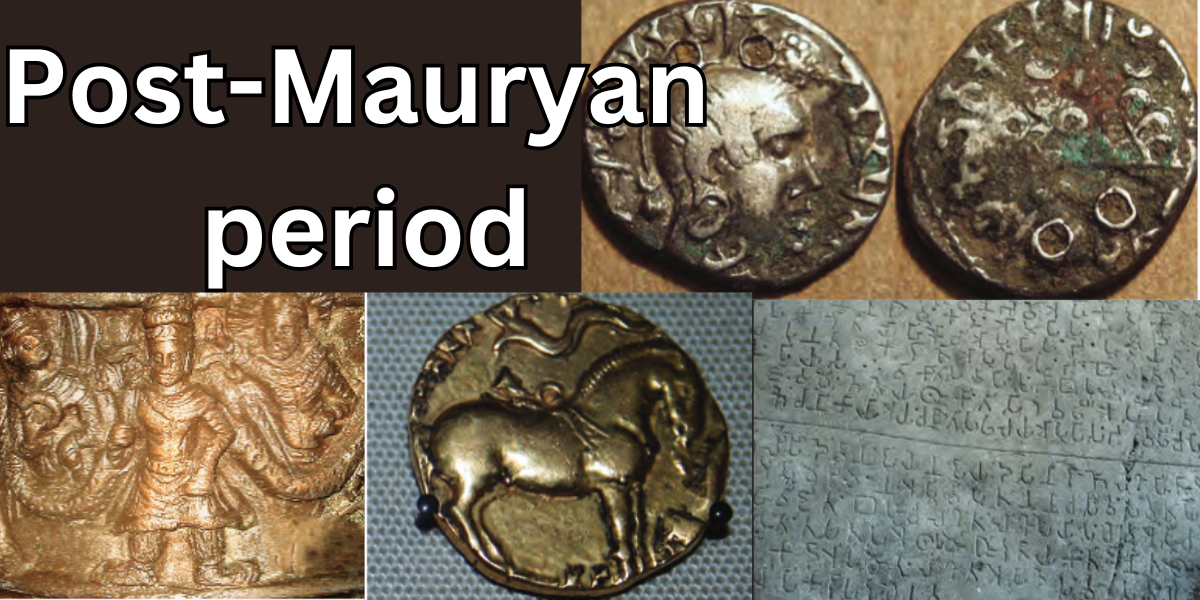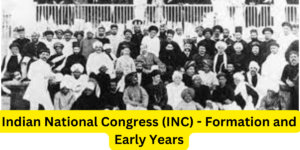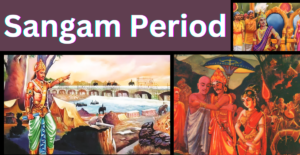Post-Mauryan period
Introduction:
The existence of Emperor Ashoka, and consequently the decline of the Mauryan Empire, and the invasions of the Indo-Greeks, Sagars and Kushanas of West Asia and Central Asia in some parts of India for the four centuries that followed.Although Magadha was not as much an empire as it used to be, it continued to be an important centre of Buddhist culture.In the south, the Satavas became independent kings.The Sungas and husbands ruled the north before the establishment of the Gupta Empire.Through extensive trade links, India became integrated with the Mediterranean regions, Central Asia and China.
Post-Mauryan period-Indo-Greeks:
Indian contact with the Greeks began when Alexander invaded northwest India and captured the Punjab region.One of Alexander’s most accomplished generals, Selycus Nicator,c.b.After 311 B.C., he established the largest rule from Phrygia (Turkey) to the banks of the Indus River.Around 305 B.C.E., Chandragupta fought against Seliuka and defeated him.Then Selicuscus and Chandragupta made a joint.Chandragupta gave 500 war elephants to Celyochus. Celyochus sent his messenger, Megasthenes, to the Mauryan court of Padadiputra. Megasthenes was the first foreign ambassador to come to India.Greek historians have noted that the second Ptolemy of Egypt sent messengers during bindusara‘s reign and bindusara’s letter to Antiochus of Syria.
Ashoka’s epigraphic order (13) refers to five Yavana kings about his friendship with the Greeks.The Greeks of India are referred to as The word is derived from the Persian word ‘Yayuna‘.The Seleucid Empire, which stretched from northern Afghanistan (Bacteria) to Syria, weakened after 250 BCE and began to disintegrate.The governor of Bactria, Diodotus, rebelled against Antioch II and became an independent king.In 212 B.C., king Judidaemus, who came after it, attempted to subjugate the Seleucid emperor, Antiochus III.But Antiochus III came as far as the Kabul River and defeated the Indian state known as Subahasena.
Demetrius:
Judidemus was succeeded by his son Demetrius (in 200 BCE).Demetrius II (175 BC) was the first known Hindu Greek king.The fine coins of the Greek kingdoms were created during his reign.They bore the image and name of the king ruling on one side. On the other side is the lonely face.In ayodhya, the historical reference to India, the layas have said that the Greeks waged war on Magadha.Around 165 BCE, Bagsia became the handiwork of parthibar and Sagar.
Minander:
The most well-known king among the Indo-Greek kings was Minander (circa 145 to 130 BC).He along with the King of Panchala plundered the Gangetic plain. The Hitikumba inscription says that even the Kalinga king Karavela could not stop him.It is in the Buddhist copy Milita-Panha that Minander is known as a proud leader.Another well-known of the Indo-Greek kings was Antialcydus (100 BC).His messenger Heliodorus was responsible for knowing about him.Heliodorus was sent as the ambassador of the Court of Bhagabhadra. He installed a pillar there. The pillar is erected as a mark of respect to the Vaishnava Sea Krishna, who has the garuda figure on the head of the pillar, also known as Garuda-Dwaja.
Post-Mauryan period-Sagar:
The Sagars put an end to the rule of these Greeks in India.The Sagars (Scythians) were nomadic tribes who entered India in large numbers and spread throughout the north and south.They are against the Nomadic tribes of Turkey. The rule of the Sadhas was established by Maos or Moga in the Gandhara. Their names are mentioned in the Mora inscription.The Sagars were the ones who were expelled from eastern Iran in the Parthian ruler Mitratessa.Then they settled in the areas between the Indus Valley and The Saurashtra of northern India.The first Sagar ruler of India was Maus or Moga (in 80 BC).
He captured Gandhara and created a rift between the Indo-Greek states.His successor Ahidan destroyed these Greek remnants and extended the rule of Sagar as far as Madurai.The Sagars appointed the Chhatraps as governorsto administer their territories.Rudradaman (130 to 150 AD) was one of the famous Sagar Chhatraps. There are references to his successes in the famous Jinagath rock inscription.
Post-Mauryan period –Kushana :
They are a group of the Yuch-chi tribe that lived in the northwestern part of China .They accepted the supremacy of the Kushanas. They gathered in the north-western parts of India to give up their nomadic customs.They captured the Kabul Valley from the Sagars. Gradually they established themselves in the north-western parts of India.They took the sagars and achieved more successes.The first Kushana king to conquer Afghanistan was Gujila Katpiches.
Kanishkar:
Kanishkara was well known to the Kushana kings.He ruled from 78 AD to 101 or 102 AD.Kanishka defeated the Chinese general Pan-hsiang.He spread the northern borders of India as far as China.Kanishka was the patron of the fourth Buddhist Magha Sangha.Kanishkara patronized the missionaries sent to China.The title of the Kushana rulers is said to be ‘King of kings‘, ‘Caesar‘ and ‘The Ruler of the Universe’.The Hesna rock inscription mentions the first two carbies, referring to Kanishka as Kushana ‘Devaputra‘ and ‘Maharajah‘.
We have got a lot of information about the Kushanas for the historians of the Department of Archaeology of the Karakoram Highway Project, which was jointly undertaken by China and Pakistan in 1979.The Kushanas followed Buddhism.Emperor Kanishka was ruled by poets such as the Buddhist teacher Nagarjuna, the Buddhist philosopher Ashvaghosa, Parswar and Vasumitra.The Kushana empire witnessed rapid decay as kanishka’s successor was incompetent and weak.
Post-Mauryan period-Sunga Dynasty:
Pushya Mitra Sunga was the commander-in-chief of the Maurya king Brihadratha. In 185 BC, he killed Bhrigathrada during a military parade and ascended the throne.Pushya Mitra Sunga founded the Sunga dynasty. The Sunga dynasty ruled for hundreds of years.They ruled with Pataliputra as their capital.They successfully defended the country against the Greek kings Menander and Demetrias.He raised vaishnavas. They were engaged in Vedic sacrifices.They supported the Sanskrit literary scholar Patanjali.The great stupa at Sanchi and the walls around it were built during the time of the Sundars.He died in 151 BC and then his son Agnimitra sat down as king.Vasumitra succeeded Agnimitra as king.Devabhuti, the last Sunga king, was killed by his minister Vasudeva Kanwar in 73 BC.
Post-Mauryan period-Kanwars:
Vasudeva was a minister of the Sunga empire of Devakuri and then assassinated him and captured a rare dam.The Kanva dynasty was founded by Vasudeva Kanwar in 73 BC.The Kanva dynasty had only 4 kings and their rule lasted only 45 years.The rise of the Guptas after the convoy of the Kanvas was a remarkable rule in the history of Magadha.
Kanva Kings :
- Vasudeva
- Bhumimitra
- Narayana
- Susarman
The Kanva kings supported the Brahmins.Susarman, the last Kanva king, was killed by the mighty chieftain Shimukha of Andhra Pradesh and planted the Simmukha Satavana dynasty.
Post-Mauryan period-Satavahanas:
The Satavahana dynasty was established in the Deccan and central India in 185 BC after the Mauryas.Simuka, the founder of satavahana dynasty, ruled for 23 years. He was succeeded by his brother Krishna. The Satavahanas ruled from Rajasthan in the north-west to Andhra Pradesh in the southeast, Gujarat in the west and Kalinga in the east.The Satavanas ruled for about 450 years.Sadarkani I expanded the empire, captured Kalinga and pushed back the Sungas. He performed two asvamedha yajnas to establish the They built Jaina and Buddhist temples.
Satavana Kings Gautamiputra Satarkani is revered as the greatest king. He defeated the Sagars and gave life to the empire.The Nashik Meikeerti, published by Mother Gautami Balashree, says that she destroyed and destroyed Sagar and Ya vanar Bhagavalavar.The Satavana king Hala was a Sanskrit scholar. He rose to fame by writing a book called Sattasai (Saptasati), which consists of 700 songs in The Prandritam language.The Satavanas excelled in architecture. Buddhist stupas were built in Amaravati.The bronze statue of Buddha in a standing posture, discovered at an archaeological site called Ok-yo in Vietnam, resembles the Amaravathi style.The Satavanas of later times issued lead or copper coins inscribed with the emblem of ships with two masts.
Archaeological evidence of Post-Mauryan period:
Inscriptions and copper swords:.
- Ayodhya inscription of Dana Deva
- Naksi Rustam inscription of Percipol
- Moga (Copper Sword of Taxila)
- Jinagath inscription
- Nasik Meikirti
- Inscription of Darius I
Coins:
- Coins of The Satavanas
- Second Kadabisin coins.
- Roman coins
Literature:
- Puranas.
- Karky Samkita.
- Harsha Charita of Panabattar.
- Kalidasa’s Malavikagnimitram.
Travel notes of The Chinese Buddhist Druvee Yuan-Chuang.





Pingback: Gupta Dynasty |administrative|Literature|Science|decline